Are There Any Wondrous Items In Oathfinder That Let You Summon A Familiar Or Animal Companion
Imagine a grizzled, former Wizard, staring downwardly from a hill. He sends his pet raven to secretly spy on the band of orcs occupying the valley. The raven flies dorsum and reports what is going on.
The adventurer with the familiar is a trope that works well in fantasy. Dungeons and Dragons is a game that has lots of pets bachelor to players, and non just to the Ranger grade. Let'south look at some of the options available to the different classes.
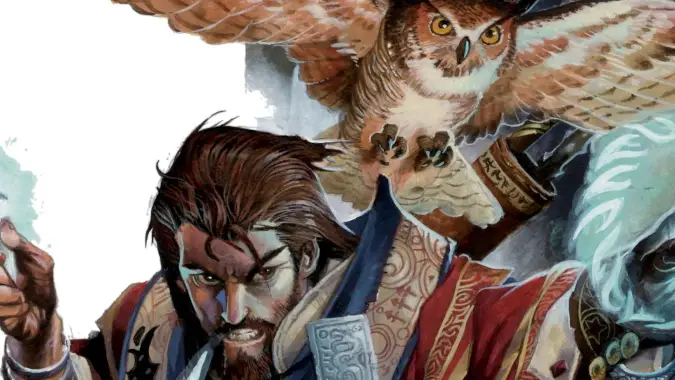
Find Familiar
Find Familiar is a Wizard spell that allows a graphic symbol to summon a animate being, to have as a pet, and to use them in or out of combat. The familiar is limited in what it can take the course of, merely there are all the same many choices within that limitation. The forms of the familiar, per the D&D Histrion Handbook are: bat, cat, crab, frog or toad, militarist, lizard, octopus, owl, poisonous ophidian, fish, rat, raven, sea equus caballus, spider, or weasel. The player chooses the shape. The shape can be consistent, or the role player could choose a different class when summoning.
Even though all of those forms are beasts, the familiar is not a beast. It is classified as either a Celestial, Fey, or Fiend. The player chooses what type of animate being the familiar is. Whichever is chosen, the creature has the statistics of the beast the role player selected for the appearance, and the abilities of that creature. For instance, if the histrion chose a Fey that appeared to be a Raven, and then the familiar uses the Raven statistics, bachelor on sites like DnDBeyond.com. Yes, it can fly.
What the familiar can do, and where it can become, is important. In gainsay or not, the grapheme can take control of the familiar, move it — separate from their own actions — and traverse into areas the character cannot. This might be because the familiar can wing, or because it is small and tin fit inside a small crevice, or perchance the familiar is a fish and swims nether water. The player'due south grapheme may also use an action to telepathically link their heed to the familiar, and feel what the familiar experiences, with all of their senses. Wing over an enemy camp and spy, or sneak through a wall and pull a switch to open a door.
A spell may too exist cast through a familiar. For instance, let's say a spell requires the target to be in touch range, that is, 5 feet away. The caster is 100 anxiety abroad, and has no way to reach the target. And so the spell would not exist able to be cast on the target. If the grapheme had a familiar, the character could ship the familiar to the target. And then they could bandage the spell through the familiar, every bit if the familiar was the pulley. There is a 100 foot limit on this, merely this does allow extra positioning on the gainsay field.
A familiar adds a lot of flexibility in game play, and a fun pet to add to the function playing. And best of all, information technology is not limited past course! Yes, information technology is a Wizard spell, but it's a level 1 Magician spell. Every class has access to a Feat called Magic Initiate. This feat allows a character to choose one level 1 spell from another class. Choose this feat, cull Find Familiar, and select the pet of your option.
Want a Rogue with a pirate theme that has a bird on the shoulder? Want a Sorcerer with a pet weasel? This is built in as an choice for just such a grapheme creation.
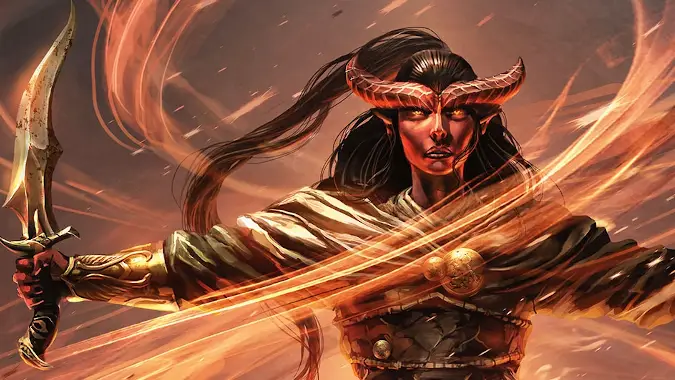
Pact of the Chain
Pact of the Chain is only for Warlocks. Information technology is described as "Find Familiar on steroids." At level 3, a warlock chooses a Pact. If they cull Pact of the Chain, they learn the Observe Familiar spell they can cast as a ritual. All the same, when the warlock uses this, they not only tin choose to summon one of the beast forms, they tin can besides choose one of the following forms: imp, pseudodragon, quasit, or sprite. The familiar, in whichever form the Warlock chooses, has nevertheless functionality every bit the 1 from Find Familiar, plus has the ability to make an attack.
This is everything a player would want in a pet class. Extra character on the combat field, another grapheme to cast a spell through, and another attack that doesn't accept away from their activity. Also, Warlocks can summon random demons that tin potentially wreak havoc on the party.

Artificer's Homunculus
The Artificer course was added in Eberron, and originally thought to be unique to that setting. Yet, equally D&D has been expanding, they have included new material for the Artificer. The Artificer is like engineering science for D&D, a class that focuses on building equipment, combining the mechanical with the magical, to create armor and weapons, and occasionally a pet.
There exists a Homunculus Servant. Originally in the Eberron setting, it was reprinted in Xanthar'southward Guide to Everything. This is learned at level 6. The Artificer infuses an particular that serves equally the creature's middle, around which the creature'due south body instantly forms. The player chooses what the homunculus looks like, and it functions appropriately. It could be a Crow, which flies, or information technology could exist a walking cauldron.
Just like the familiar, this pet functions separately in gainsay, and the Artificer can cast spells through information technology, as if that was the space the Artificer was continuing. Unlike the familiar that can just be re-summoned, the homunculus needs to exist rebuilt, and all materials and cost need to exist spent again.
Homunculus Servant has an assail, Force Strike, and besides has an Evasion reaction, to help information technology stay live when it is attacked. This is a mechanical pet the Artificer builds and keeps by their side.
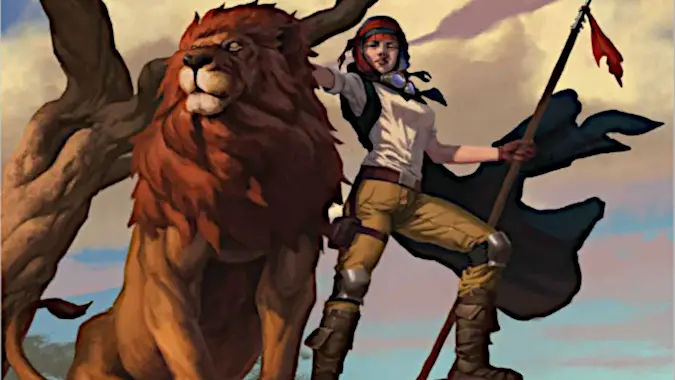
Beast Master Ranger
Fauna Master is a subclass the Ranger can choose at level 3. In the current incarnation of Beast Master, the Ranger character must use an activity as if they are telling their pet beast what to do. The Ranger finishes their plow, so their pet takes their turn. If the Ranger used an action to command the pet, the pet so follows that action. The pet's activeness took the place of the Ranger's action.
At levels 3 and iv, this means that the Ranger does non assault. At level 5, the Ranger learns Extra Attack. The Ranger tin and then employ its action to guild the pet to set on, and then perform Extra Attack to make an assault of their own. The pet then takes its plow immediately after. The Animal Master Ranger never learns any boosted attacks, through level 20, this is the extent of the attacks performed.
If the pet is killed, the pet cannot be revived. A Ranger must find and tame a new pet. Unlike the familiars, a pet that had personal meaning to the player is gone. This goes against the emotional ties of a pet. Equally a Ranger goes up in level, they are able to tame higher level beasts, and there is an expectation they would want new pets. This would be heavy on the character from a function playing aspect.
There is some saving grace to this bracket. Unearthed Arcana is newer supplemental material to D&D. It is in the Beta testing phase at this time. None of this should yet be considered official D&D cloth, equally information technology could change. In any D&D session, players would need to consult with their Dungeon Master if this material could be used.
In Unearthed Arcana, there are many changes for the Ranger class, including the Creature Caucus — the new name for the Animate being Master subclass. Now the pet can assail at the same time as the Ranger. The pet is able to be revived if it dies. There will be a small, specific listing of starting pets. Currently, the Ranger may start with whatever low-level animal. While the flexibility may seem like a positive, there are only a few beasts that are viable, and as well many beasts are not efficient pets, some will not have an attack. This will ensure the Ranger pet will be guaranteed to be useful from the showtime. Hopefully these changes volition exist made official soon, maybe fifty-fifty before the rest of Unearthed Arcana is released.
Mounts and Other Beasts of Burden
At level 5, Paladins learn Find Steed, which allows them to summon a spirit that takes the course of an animal they can ride. Commonly this is a equus caballus, but it could be a camel, an elk, or a giant mastiff. Bards tin larn this with an ability to acquire magic spells from other classes. Other classes will too learn mounts. Some will take started the game with enough golden to purchase a mule and a cart. Others will save upwardly, buy a warhorse and exist a Cavalier Fighter with the ability for mounted combat.
This mount becomes a role of the group, at least a pet, if not a character in their own right. Eventually the adventurers will desire to upgrade to flying mounts, like griffons or giant eagles. The game is always better with the addition of flying mounts.
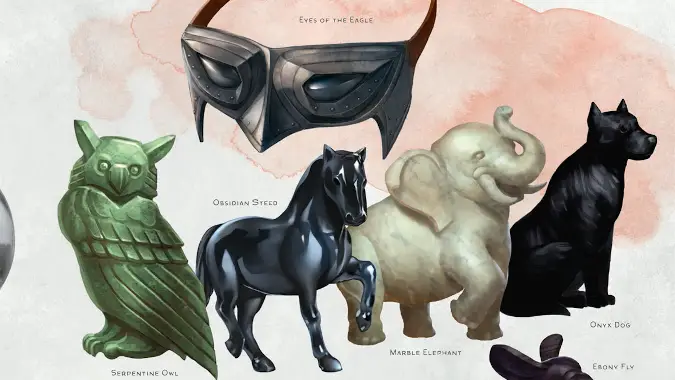
Figurine of Wondrous Power
This is non exactly a pet. This isn't reliable, as it will mean the DM has to include it in the game, either as treasure, or at an affordable toll. And there is a cooldown on their usage. However, this is an official detail listed in D&D: Figurine of Wondrous Power.
This is a collection of tiny statuettes of different animals, a menagerie of magical items with dissimilar abilities. Among others, there is an Ivory Caprine animal that tin be used as a riding equus caballus. There are a pair of Gilded Lions that can exist used in combat. There is a Silver Raven that sends messages to others.
These items are all reusable, and the animals could exist seen equally pets. Animals that a actor'southward character calls out over and over, the same animal each time, that the character has a connectedness with. Just give the animal a name, and it makes it personal.
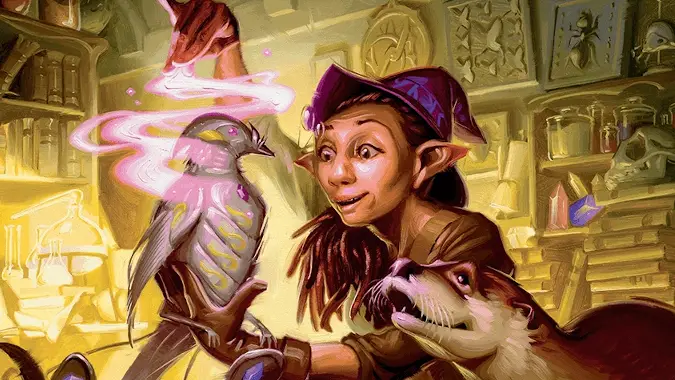
Conjuring The Same Creatures
This next i is catchy. These aren't pets in the sense that the player'due south character keeps them, and whether or not they e'er appear is up for debate. There are a number of spells that conjure a creature to assist the role player. They can be completely random or have some direction in what appears, and if they are not completely random, in that location is discussion if the player decides what is conjured or if information technology is solely upward to the DM's discretion. There is room for the histrion and the DM to decide if the histrion'southward character could ever summon the same being when using these spells. This is non necessarily a pet, merely could act in a similar fashion.
These spells include, but are not express to: Conjure Animals, Conjure Celestial, Conjure Minor Elementals, and Conjure Woodland Beings.
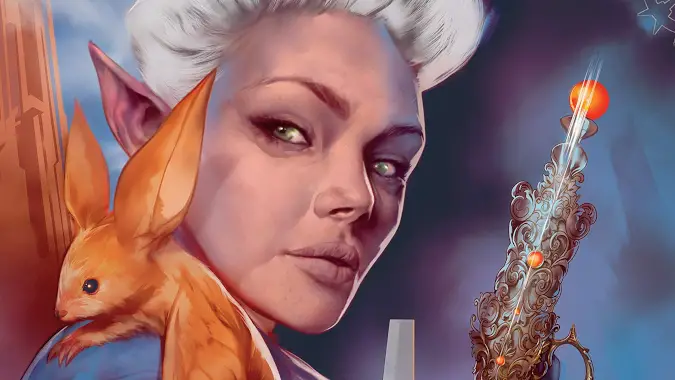
Non-Gainsay Pets
There is enough of room in D&D for pets that don't affect gainsay. The spell Speak With Animals allows characters to talk to animals, form a bail, and make them office of the group. Animal Treatment could tame a creature, and take them on as a pet. The group could stumble upon a dragon egg and hatch it, then the dragon whelp mistakes the showtime graphic symbol it sees equally its parent, and forms a bond. A queen in the Fey Wilds might be impressed with the group of adventurers, and bestows upon them a Blink Canis familiaris pup every bit a reward.
This is entirely up to the DM and the players — and for anybody to talk nearly, to make certain they agree, and don't unbalance the game. There is a lot of flexibility. That's the nifty affair about it beingness pencil and paper — or text and screen. The rules are guidelines, just can exist bent and changed to create what is fun for everyone. And what'southward more fun than pets?
Source: https://blizzardwatch.com/2020/04/09/how-to-play-with-pets-in-dnd/
Posted by: campbellthrecties61.blogspot.com

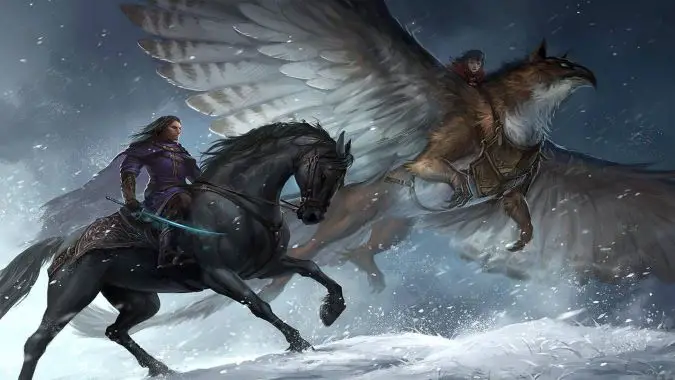
0 Response to "Are There Any Wondrous Items In Oathfinder That Let You Summon A Familiar Or Animal Companion"
Post a Comment